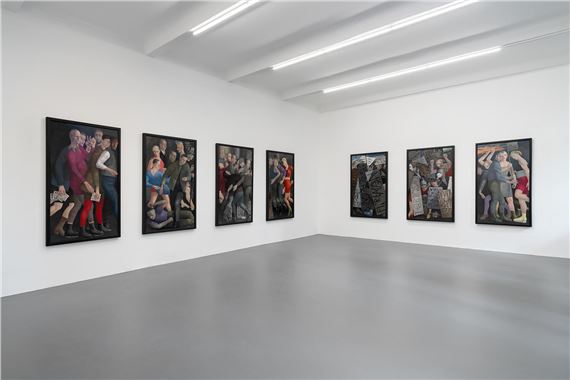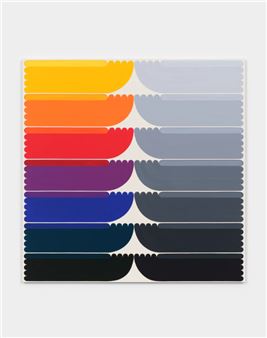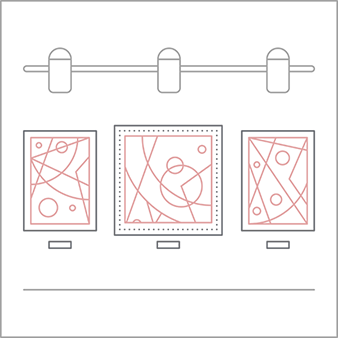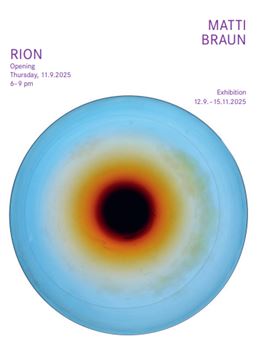Volker Stelzmann: Thicket
Volker Stelzmann has named his twelfth solo exhibition at Galerie Poll “Thicket”. The gallery has represented the painter for over thirty years.
Stelzmann’s work is characterised by great continuity. Over the years, he has created his own universe of images through his distinctive language of forms. He continually invents new, sophisticated arrangements and compositions for his groups of figures. Limbs whirl around, people stand closely packed side by side or one behind the other, without any apparent interaction. They wear fashionable clothing such as hoodies or neon-coloured trainers with thick soles, notable hairstyles, or headgear. The faces, with wide-open eyes, are expressive and yet seem frozen into masks.
“Stelzmann observes his contemporaries on the street as intensely as he does the beloved Renaissance painters and Mannerists, whose works he discovered even in the most remote villages during his numerous trips to Italy. To him, history is not something distant, but omnipresent. Conversely, those modern people he depicts become part of a cross-era study of humanity – as well as a timeless reflection on what painting can achieve in the interplay of tradition and innovation” (Sebastian Preuss, 2020).
Stelzmann ironically comments on the daily news with paintings like “The Tortoise”, named after a marching formation of Roman legionnaires, or “Barrier”. People almost completely disappear behind banners with slogans like LGBTQ, DIVERS, KLIMAFASCH, or WHITE MEN, which one can complete themselves. Two “Knife Men” threaten a person in the painting of the same name, while others watch helplessly or flee.
Each of Stelzmann’s images is based on a precise observation of his environment, without any didactic intention with his paintings. The artist repeatedly paints himself as an observer (“Self-portrait with Grey-Green Cap”) or blends in with his wife Henriette among the group of people (“Frieze of Heads I”).

Volker Stelzmann has named his twelfth solo exhibition at Galerie Poll “Thicket”. The gallery has represented the painter for over thirty years.
Stelzmann’s work is characterised by great continuity. Over the years, he has created his own universe of images through his distinctive language of forms. He continually invents new, sophisticated arrangements and compositions for his groups of figures. Limbs whirl around, people stand closely packed side by side or one behind the other, without any apparent interaction. They wear fashionable clothing such as hoodies or neon-coloured trainers with thick soles, notable hairstyles, or headgear. The faces, with wide-open eyes, are expressive and yet seem frozen into masks.
“Stelzmann observes his contemporaries on the street as intensely as he does the beloved Renaissance painters and Mannerists, whose works he discovered even in the most remote villages during his numerous trips to Italy. To him, history is not something distant, but omnipresent. Conversely, those modern people he depicts become part of a cross-era study of humanity – as well as a timeless reflection on what painting can achieve in the interplay of tradition and innovation” (Sebastian Preuss, 2020).
Stelzmann ironically comments on the daily news with paintings like “The Tortoise”, named after a marching formation of Roman legionnaires, or “Barrier”. People almost completely disappear behind banners with slogans like LGBTQ, DIVERS, KLIMAFASCH, or WHITE MEN, which one can complete themselves. Two “Knife Men” threaten a person in the painting of the same name, while others watch helplessly or flee.
Each of Stelzmann’s images is based on a precise observation of his environment, without any didactic intention with his paintings. The artist repeatedly paints himself as an observer (“Self-portrait with Grey-Green Cap”) or blends in with his wife Henriette among the group of people (“Frieze of Heads I”).
Artists on show
Contact details


 ARTISTS
ARTISTS










